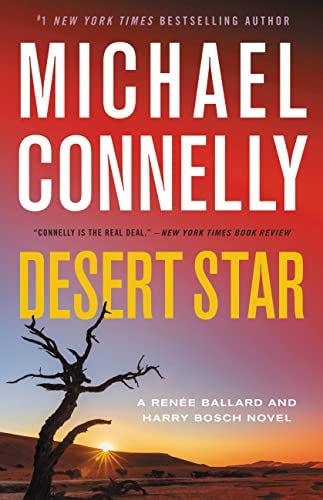"People Say There Is No God": A Review of Michael Connelly's "Desert Star"
Early in Desert Star, the new Michael Connelly novel, Harry Bosch drives to the Mojave Desert. (As is his custom, Connelly gives us the route markers: “He got up to the 210 freeway and headed east in very light traffic until he reached the 15 and turned northeast. . . .” Strange how these mundane details weave their spell.) Bosch is heading to the desolate site where a family of four, the Gallaghers—father, mother, young son, and daughter—were buried by their murderer nine years before. They’d lived in the San Fernando Valley, but the killer transported their bodies to this remote spot to bury them. A year later, a “Cal State geological expedition studying the nearby salt pan for evidence of climate change” accidentally uncovered the remains.
Bosch had good reason to believe that the murderer was a man named Finbar McShane, who’d worked for the dead father, but he hadn’t been able to find enough evidence, and McShane had disappeared. The investigation ran out of steam, and not long after that, Bosch retired from the LAPD, though he has continued to work cases wearing various other hats, in the course of which he met Renée Ballard, the LAPD detective introduced by Connelly in the 2017 novel The Late Show. Ballard is much younger than Bosch, and the bond between them is not at all romantic; rather, it is based on a mutual commitment to achieve justice, such as it can be found, for murder victims especially—a commitment that doesn’t merely come with the job but rather gives them their reason for existence.
At the very beginning of Desert Star, Ballard contacts Bosch to see if he wants to join a newly reconstituted Open-Unsolved Unit (after a period during which, as a result of budget cuts, the unit had been shut down), with Ballard herself in charge. This will give Harry a chance to reopen the Gallagher Family case, which has continued to haunt him. At the same time, he’ll need to work on other cold cases, particularly the 1994 murder of a sixteen-year-old girl, Sarah Pearlman, whose brother, Jake, now a city councilman, is responsible for getting the unit reopened, with the hope that at last the killer of his sister will be found. Together, these two cold cases drive the book’s action.
When it comes to shifting back and forth between different plot-threads without losing the reader’s attention, Connelly has no peer among contemporary crime novelists. Indeed, just as he toggles deftly between the two cold cases that will, if solved, justify the unit’s revival, Connelly shifts effortlessly from Bosch’s personal quest (and his distinctive point of view) to Ballard’s (equally distinctive). The result is so propulsive that, even though this novel (Connelly’s thirty-seventh) runs to almost 400 pages, many readers won’t want to put it down once they’ve picked it up.
During that scene early in the book when Bosch revisits the site where the murderer buried his victims (wrongly supposing their bodies would never be found), he notices that “a profusion of flowers had sprouted among the rocks. Each flower had a yellow button center surrounded by white petals.” He decides to rebuild the modest memorial he’d constructed years earlier with Beto Orestes, an Inyo County colleague he’d worked with on the case before it was shelved. Orestes, meanwhile, has been alerted to Harry’s presence by a camera that the sheriff’s office installed on the nearby road a couple of years earlier, and he shows up to touch base. As they are talking, Orestes bends down and picks up one of the flowers that had caught Bosch’s eye when he arrived.
“Hard to believe something so beautiful can exist in this place,” he said. “And people say there is no God. You ask me, there’s God right there.”
He turned the stem between his fingers, and the flower turned like a pinwheel.
“You know what that is?” Bosch asked.
“Sure,” Orestes said. “This one’s called the desert star.”
Bosch nodded. He wasn’t convinced it was God on earth, but he liked that.
That should give you enough to go on—enough to know (if you are still on the fence) whether this book is one you want to hunker down with. As for me, I’m already looking forward to my first re-reading of it, even though it's the kind of story that leaves you feeling sad and shaken.
Click here to buy a copy of Desert Star through our bookshop.org page.






